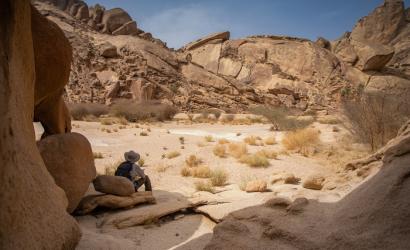The Red Sea Development Company has unveiled plans to become the largest certified Dark Sky Reserve in the world.
The location is seeking an accreditation that recognises areas with an exceptional quality of starry nights and a commitment to protecting the nocturnal environment.
The company has awarded a contract to Cundall, an international multi-disciplinary consultancy providing engineering, design and sustainable solutions, to develop a lighting strategy that would provide enough lighting for safe movement around the site, while meeting the stringent International Dark Sky criteria.
“We are proud to announce our intention to become the first full-scale destination in the Middle East to pursue this unique accreditation, intended to safeguard the natural environment and allow guests to marvel at the beauty of the night sky,” said John Pagano, chief executive of the Red Sea Development Company.
“Over the centuries, explorers, trade caravans and pilgrims have used the night sky to navigate across our region.
“Dark Sky accreditation will allow our visitors to enjoy the same stunning night-time panoramas that guided and inspired those historical travellers.
“We are proud to become part of a worldwide movement dedicated to restoring mankind’s intimate relationship with the stars.”
According to a study for Science Advances, it is estimated that the Milky Way is no longer fully visible to one-third of humanity — including 60 per cent of Europeans and 80 per cent of Americans.
Artificial light from cities has created a permanent “skyglow” at night, obscuring views of the stars.
The internationally recognised Dark Sky accreditation aligns with the Red Sea Development’s commitment to deliver an exclusive experience of unparalleled diversity while enhancing the destination’s extraordinary natural wonders.
The company recognizes the threat of light pollution and the impact it has on the environment and resident species like the critically endangered hawksbill turtle.
Cundall will work with the engineering and development teams at the Red Sea Development Company over a six-month period to review the existing project design and advise on possible measures to reduce light pollution.
This includes outreach to local communities advising residents on suitable measures they can undertake to support the initiative and encourage more energy-efficient, lower-cost use of external lights.
In March, the team will record the baseline condition, surveying the existing lighting equipment and installation details on all existing assets including building-mounted general lighting, feature lighting, landscape lighting and street lighting.
In addition to recording the lighting condition, sky quality measurements will be made across the destination.
The combination of the survey information and measurements will provide a baseline condition of the quality of the existing dark skies that people experience and how existing lighting contributes to sky glow.
A lighting management plan will be produced which will describe improvement works throughout the existing lighting at the destination and inform the lighting design for each of the new assets, including hotels, the airport and residential properties.
An application will then be made to achieve dark sky reserve status for the entire destination.
Image: Nicolas Maniero
You can read more of the news on source
 Travelsmart
Travelsmart



